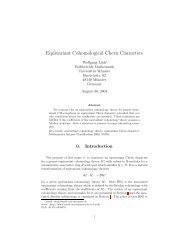On some notions of good reduction for endomorphisms of the ...
On some notions of good reduction for endomorphisms of the ...
On some notions of good reduction for endomorphisms of the ...
Create successful ePaper yourself
Turn your PDF publications into a flip-book with our unique Google optimized e-Paper software.
In general, <strong>the</strong> <strong>reduction</strong> modulo v <strong>of</strong> rational maps does not commute with <strong>the</strong><br />
composition <strong>of</strong> rational functions. For example consider<br />
Φ(x) = x2 + x<br />
x + p<br />
and<br />
Ψ(x) = px<br />
<strong>for</strong> a given prime integer p. We have<br />
(Φ ◦ Ψ) p = x<br />
x + 1<br />
But if <strong>the</strong> maps Φ and Ψ have both S.G.R. at v <strong>the</strong>n<br />
and Φ p ◦ Ψ p = 1.<br />
(Φ ◦ Ψ) v = Φ v ◦ Ψ v .<br />
(See Theorem 2.18 in [12]). In order to have <strong>the</strong> commutativity <strong>of</strong> <strong>reduction</strong> modulo<br />
v and composition it is not always necessary to have <strong>the</strong> S.G.R. <strong>for</strong> both maps. For<br />
example <strong>the</strong> following result holds:<br />
Lemma 2.3. Let Φ be an endomorphism <strong>of</strong> P 1 defined over K. Let α and β two v-<br />
invertible rational maps (i.e. <strong>the</strong>y are associated to two elements in PGL(2, O v )). Then<br />
it holds<br />
(α ◦ Φ ◦ β) v = α v ◦ Φ v ◦ β v .<br />
Pro<strong>of</strong>. Let<br />
α(x) = ax + b<br />
cx + d<br />
, Φ(x) =<br />
f(x)<br />
g(x)<br />
be represented in v-reduced <strong>for</strong>m. Now observe that <strong>the</strong> function<br />
(α ◦ Φ)(x) =<br />
af(x) + bg(x)<br />
cf(x) + dg(x)<br />
(2)<br />
is represented in v-reduced <strong>for</strong>m. This follows by considering a representation <strong>of</strong> α −1 in<br />
v-reduced <strong>for</strong>m:<br />
let<br />
α −1 (x) = lx + r<br />
sx + t ,<br />
where l, r, s, t ∈ O v and <strong>the</strong> following identity holds<br />
( ) ( ) ( )<br />
l r a b 1 0<br />
= ,<br />
s t c d 0 1<br />
<strong>the</strong>n ( ) ( )<br />
l r af(x) + bg(x)<br />
s t cf(x) + dg(x)<br />
=<br />
( ) f(x)<br />
.<br />
g(x)<br />
If (2) were not in <strong>the</strong> reduced <strong>for</strong>m, <strong>the</strong>n also Φ = f/g would not too.<br />
8

















